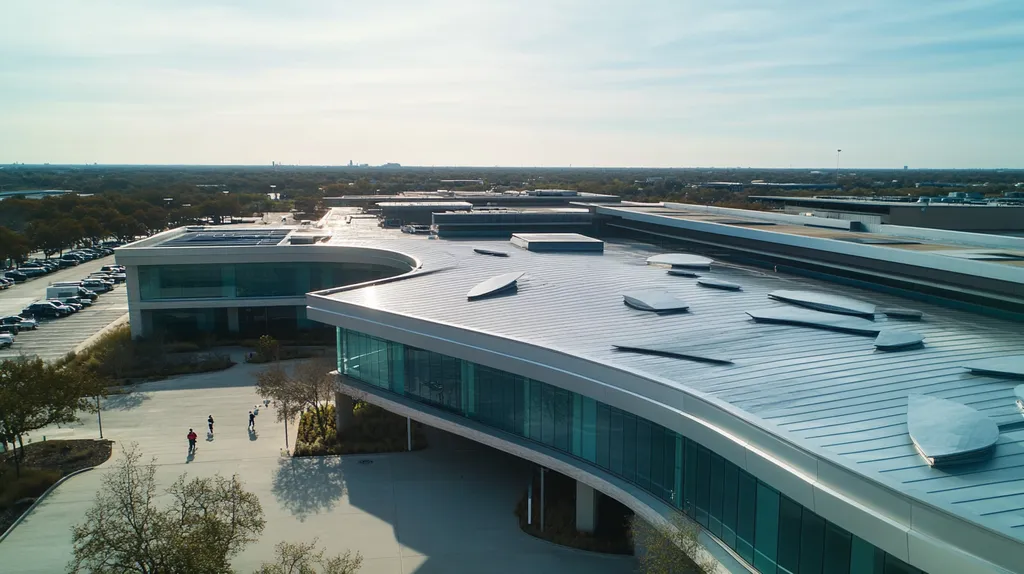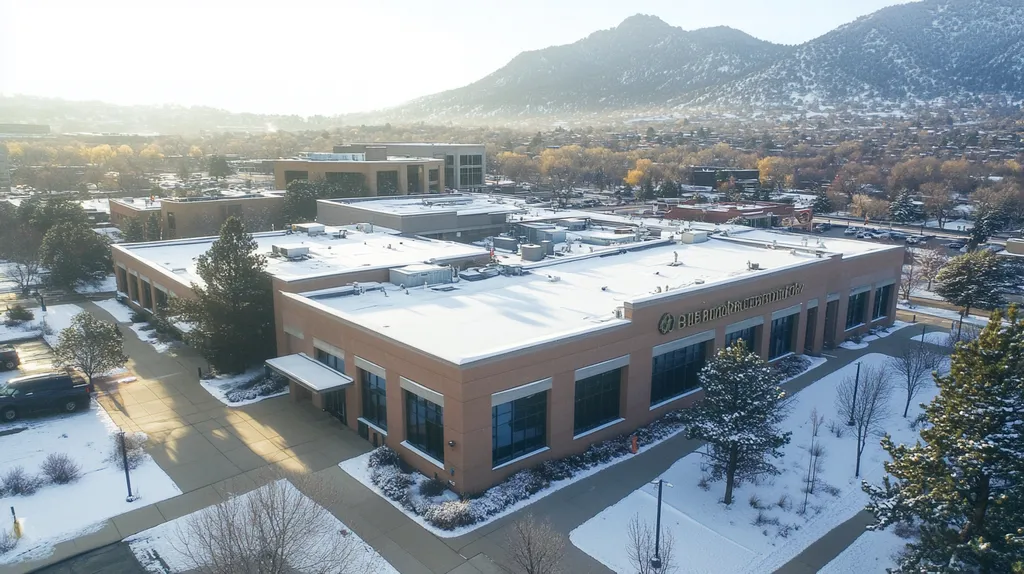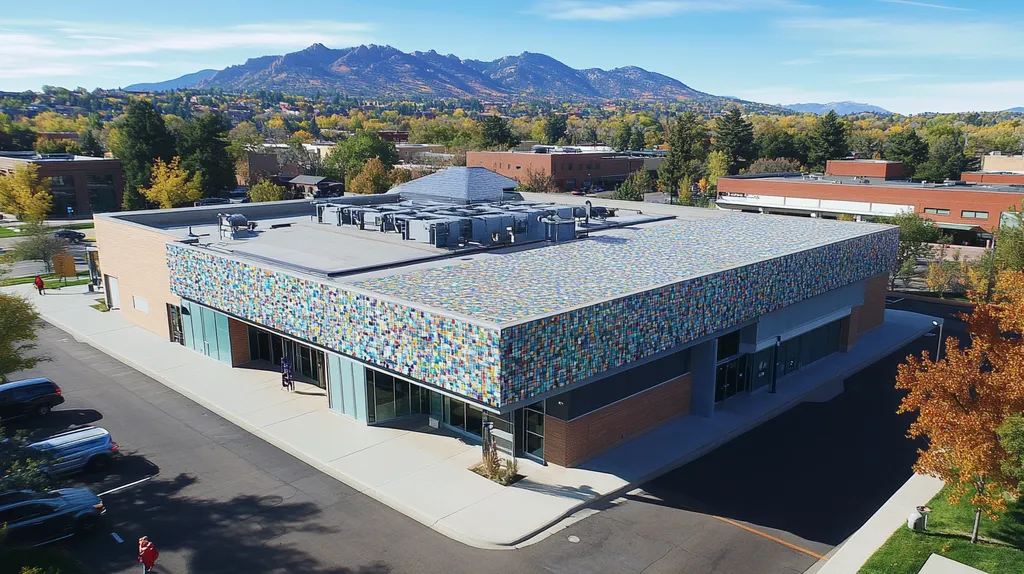Commercial roof penetrations represent critical vulnerabilities that can reduce building lifespan by decades if improperly managed. Industry studies show that up to 80% of all roof leaks occur around these essential openings, from HVAC units to plumbing vents.
Each penetration creates a potential point of failure requiring specialized materials, precise installation methods, and ongoing maintenance to maintain structural integrity.
This comprehensive guide examines the crucial factors affecting penetration performance, from fundamental concepts through advanced optimization strategies that protect commercial roofing investments.
SECTION 1: FUNDAMENTAL CONCEPTS
Every commercial roof contains multiple penetrations that impact its long-term performance and durability. From HVAC units to plumbing vents, these necessary openings create vulnerable points that require careful attention. Studies show that up to 80% of all commercial roof leaks occur around penetrations, making their proper installation and maintenance critical for protecting building assets.
Types and Roles of Roof Penetrations
Commercial roof penetrations serve essential building functions through various mechanical, electrical, and plumbing systems. Common types include HVAC units, exhaust fans, skylights, pipes, electrical conduits, and roof drains – each requiring specific installation methods and ongoing maintenance.
The size and complexity of these penetrations vary significantly, from simple pipe boots to large mechanical curbs supporting heavy equipment. Each penetration must be properly flashed and sealed to maintain the roof’s watertight integrity while allowing necessary building operations.
Strategic placement of penetrations affects both roof performance and building efficiency. Clustered penetrations can create maintenance challenges, while scattered placement may require more extensive flashing and increase potential failure points.
Modern roofing systems incorporate specialized flashing materials and installation techniques designed specifically for different penetration types. These innovations help extend service life when properly maintained.
Impact of Penetrations on Roof Integrity
Penetrations inherently create stress points in the roofing system where different materials and components intersect. These transitions require careful detailing to prevent water infiltration and maintain structural integrity.
Weather exposure particularly affects penetration performance over time. Materials with higher hail impact ratings experience less damage during storms, reducing repairs and maintenance costs around vulnerable penetration points. (source: Blue Team Corporation)
Thermal movement causes ongoing stress as materials expand and contract at different rates. This cyclical movement can compromise seals and flashings, particularly where rigid penetrations meet flexible roofing materials.
Regular inspection of penetration points helps identify early signs of deterioration. Catching issues early prevents minor problems from escalating into major failures that compromise the entire roofing system.
Common Failure Modes and Risk Factors
Most penetration failures stem from three primary sources: improper installation, material degradation, and mechanical damage. Installation errors often involve incorrect flashing techniques or inadequate sealing methods that create immediate vulnerabilities.
Environmental factors accelerate deterioration around penetrations. UV exposure breaks down sealants, while freeze-thaw cycles can create gaps between components. Wind-driven rain exploits these weaknesses, leading to leaks.
Maintenance activities themselves can inadvertently damage penetration assemblies. Foot traffic during equipment servicing and improper repair techniques often create new problems while addressing existing ones.
Age-related deterioration affects different penetration components at varying rates. Sealants typically require replacement before flashing materials, while metal components may corrode if not properly protected.
Understanding these failure modes enables proactive maintenance strategies that extend roof life. Regular inspections focused on high-risk areas help prevent catastrophic failures.
SECTION 2: SYSTEM COMPONENTS
Commercial roof system components must work in harmony to protect buildings from water intrusion and structural damage. Studies show that penetrations are responsible for up to 90% of all roof failures, making proper component selection and installation critical. Understanding these essential elements helps facility managers make informed decisions about maintenance and replacement schedules.
Flashing Materials and Configurations
Modern flashing systems utilize multiple materials to create redundant water barriers. Base flashings typically consist of modified bitumen, EPDM, or TPO membranes that integrate with the main roof covering.
Counter flashings provide additional protection by directing water away from critical junctions. These metal components must be properly sized and secured to prevent wind uplift while accommodating thermal movement.
Pre-manufactured flashing boots offer standardized solutions for common penetrations like pipes and vents. These components typically include reinforced corners and built-in expansion joints to prevent splitting.
Proper flashing height and overlap dimensions are crucial for long-term performance. Industry standards require minimum heights of 8 inches above the roof surface for most applications.
Insulation and Coverboard Interface at Penetrations
Improperly installed or maintained penetrations can lead to leaks, structural damage, and premature roof failure. The interface between insulation layers and penetrations requires careful detailing to maintain thermal efficiency and structural integrity. (source: EagleView)
Tapered insulation systems help direct water away from penetrations. This reduces ponding water that can compromise seals and accelerate material degradation.
High-density coverboards provide a stable substrate for flashing attachments. These boards must be properly secured and sealed to prevent moisture migration between layers.
Thermal bridging at penetrations can create condensation issues if not properly addressed. Proper insulation detailing helps maintain consistent temperatures across the roof assembly.
Penetration Sealing Accessories and Devices
Specialized sealing devices protect vulnerable transition points where different materials meet. Pitch pans, equipment curbs, and pipe seals each serve specific functions in maintaining water-tight barriers.
Modern sealant technologies offer improved flexibility and UV resistance compared to traditional materials. Two-part urethane sealants provide better long-term performance than conventional caulks.
Compression-type seals help accommodate building movement while maintaining watertight connections. These components must be properly sized and installed to prevent over-compression or separation.
Regular inspection and maintenance of sealing accessories prevents minor issues from escalating. Replacement schedules should align with manufacturer warranties and observed performance.
SECTION 3: IMPLEMENTATION METHODS
Proper implementation of roof penetration methods directly impacts building protection and operational costs. Recent industry data shows that penetration-related failures account for over 60% of premature roof replacements in commercial buildings. Understanding and executing correct installation techniques, choosing appropriate flashing systems, and managing ongoing movement stresses can extend roof life by decades while reducing maintenance expenses.
Best Practices for Penetration Installation
Successful penetration installation begins with careful planning and precise measurements. Each opening must be properly sized and reinforced to prevent structural weakness while maintaining watertight integrity.
Quality control during installation requires systematic verification of each component’s placement and attachment. This includes checking proper overlap dimensions, securing methods, and material compatibility at every transition point.
Improperly installed or maintained roof penetrations are one of the most common sources of leaks, structural damage, and premature roof failure. Accurate identification and evaluation of penetrations during installation ensures compliance with building codes while maximizing durability. (source: Eagleview US)
Documentation of installation methods creates accountability and establishes baseline conditions for future maintenance. This includes photographing critical details and recording specific materials used at each penetration point.
Prefabricated vs. Field-Fabricated Flashings
Prefabricated flashings offer consistent quality and simplified installation processes. These factory-made components eliminate variables in material thickness, seam placement, and overall dimensions.
Field fabrication allows customization for unique situations but requires higher skill levels. Success depends heavily on installer experience and proper material selection for specific conditions.
Cost comparisons must consider both initial installation expenses and long-term maintenance requirements. While prefabricated units often cost more upfront, reduced labor time and lower failure rates typically offset this investment.
Weather conditions during installation significantly impact field fabrication quality. Prefabricated components reduce these environmental risks by limiting on-site assembly requirements.
Managing Thermal and Moisture Movement Around Penetrations
Temperature fluctuations cause continuous expansion and contraction of roofing materials. Strategic placement of expansion joints and flexible connections helps absorb this movement without compromising watertight integrity.
Moisture migration through and around penetrations requires careful management through proper vapor barriers and ventilation. This prevents condensation buildup that can deteriorate supporting structures.
Regular monitoring of movement patterns helps identify potential stress points before failure occurs. This includes checking for material separation, sealant degradation, and flashing displacement.
Seasonal adjustments may be necessary to maintain optimal performance as environmental conditions change. This includes re-tightening fasteners and refreshing sealants at critical junctions.
SECTION 4: MAINTENANCE REQUIREMENTS
Neglected roof penetrations represent the single greatest threat to commercial roof longevity, with studies showing they account for over 75% of premature system failures. Each compromised penetration point can allow thousands of gallons of water into a building annually, leading to structural damage, equipment failures, and business disruptions. Implementing a rigorous maintenance program focused on penetration points provides the highest return on investment for extending roof life.
Regular Inspection Techniques for Penetrations
Successful penetration maintenance begins with establishing clear inspection protocols and schedules. Semi-annual comprehensive inspections should be supplemented with quarterly quick checks of high-risk areas.
Modern inspection techniques combine visual assessment with advanced moisture detection technology. Thermal imaging can reveal hidden water infiltration before visible damage occurs.
Documentation must include detailed photos and measurements of each penetration point. This creates a baseline for tracking deterioration rates and planning preventive maintenance.
Access points for inspections should be clearly marked and maintained. Creating safe pathways helps protect both the roof surface and maintenance personnel during regular checks.
Common Signs of Penetration Deterioration
Early warning signs of penetration failure include separation between flashing layers, cracked sealants, and loose fasteners. These indicators often appear months before actual leaks develop.
Improperly installed or maintained penetrations can lead to leaks, structural damage, and even premature roof failure. Accurate identification and evaluation of penetrations during inspection ensures compliance with building codes while maximizing durability. (source: EagleView Technologies)
Surface staining around penetrations indicates active water infiltration. The pattern and extent of staining help determine the source and severity of the problem.
Metal components showing corrosion or displacement require immediate attention. These issues compound quickly, especially around mechanical equipment penetrations.
Repair and Replacement Protocols
Every repair must follow manufacturer-approved protocols to maintain warranty coverage. This includes using compatible materials and following specified installation methods.
Temporary repairs should never become permanent solutions. Schedule complete repairs within 30 days of identifying issues to prevent progressive damage.
Quality control measures must verify proper attachment, overlap dimensions, and seal integrity. Testing repaired areas under controlled water exposure confirms watertight conditions.
Maintain detailed records of all repairs including materials used, methods employed, and follow-up inspections. This documentation supports warranty claims and helps optimize future maintenance planning.
SECTION 5: PERFORMANCE METRICS
Measuring roofing system performance directly impacts building protection and operational costs. Studies show that penetrations reduce average commercial roof lifespans by 40% when improperly managed. Understanding key metrics around water resistance, thermal efficiency, and material durability enables facility managers to make data-driven decisions that protect their investment while minimizing maintenance costs.
Leak Resistance and Waterproofing Standards
Water infiltration through penetrations represents the leading cause of premature roof failure. Modern testing protocols measure resistance under both static and dynamic conditions to simulate real-world exposure.
Standardized testing procedures evaluate membrane integrity around common penetration types. These assessments measure both initial installation quality and ongoing performance as materials age.
Improperly installed or maintained penetrations can lead to leaks, structural damage, and premature roof failure. Accurate identification and evaluation of penetrations ensures compliance with building codes while maximizing durability. (source: EagleView)
Digital monitoring systems now provide real-time leak detection around critical penetration points. This technology enables immediate response to developing issues before significant damage occurs.
Thermal Bridging and Energy Efficiency Considerations
Thermal imaging reveals heat loss patterns around roof penetrations that impact building efficiency. Proper detailing and insulation at these transition points can reduce energy costs by up to 25%.
Advanced materials including aerogel-based products provide superior thermal resistance at penetration points. These innovations help maintain consistent internal temperatures while minimizing condensation risks.
Regular efficiency audits quantify the impact of penetration-related heat transfer on overall building performance. This data helps prioritize upgrades and repairs that deliver the greatest energy savings.
Integration of smart sensors enables continuous monitoring of thermal performance around penetrations. Early detection of insulation failures prevents cascading efficiency losses over time.
Longevity and Durability Assessment Methods
Material testing protocols simulate decades of weathering effects on penetration assemblies. These accelerated aging procedures identify potential failure points before they manifest in the field.
Digital modeling tools predict stress concentrations around different penetration configurations. This analysis helps optimize design details for maximum service life.
Performance tracking systems document the degradation rates of various penetration components. This data informs maintenance schedules and replacement planning.
Field verification methods including pull testing and infrared scanning evaluate ongoing structural integrity. Regular assessments catch developing issues while repairs remain minor and cost-effective.
SECTION 6: OPTIMIZATION STRATEGIES
Strategic optimization of commercial roof penetrations can dramatically extend system lifespan while reducing maintenance costs. Studies show that optimized penetration designs reduce leak potential by up to 85% compared to standard installations. Without proper optimization, even well-installed penetrations begin failing within 5-7 years, leading to extensive repair costs and potential interior damage. Understanding and implementing key optimization strategies is crucial for protecting commercial roofing investments.
Advanced Flashing Design for Enhanced Durability
Modern flashing systems incorporate redundant waterproofing layers and flexible materials that accommodate building movement. These advanced designs focus on directing water away from vulnerable seams while maintaining watertight integrity under extreme conditions.
High-performance metals like stainless steel and aluminum alloys provide superior corrosion resistance compared to traditional galvanized materials. These premium components often deliver 2-3 times longer service life in challenging environments.
Integration of pre-manufactured corner pieces and transition elements eliminates high-risk field fabrication points. This standardization significantly reduces installation variables while ensuring consistent performance across all penetration locations.
Advanced sealant technologies now offer 20+ year performance ratings when properly installed and maintained. These materials maintain flexibility while resisting UV degradation and thermal cycling.
Integrating Penetration Details into Roof System Design
Improperly installed or maintained penetrations can lead to leaks, structural damage, and premature roof failure. Accurate identification and evaluation of penetrations during design ensures compliance with building codes while maximizing durability. (source: EagleView Technologies)
Strategic grouping of penetrations reduces overall vulnerability points while simplifying long-term maintenance access. This approach requires careful coordination between mechanical, electrical, and plumbing systems during initial design phases.
Dedicated equipment zones with enhanced substrate reinforcement provide better load distribution and simplified flashing details. These zones incorporate additional drainage features and maintenance walkways to protect the surrounding roof areas.
Three-dimensional modeling tools enable precise penetration placement while identifying potential conflicts before installation. This technology helps optimize drainage patterns and minimize areas where water might collect.
Mitigating Condensation and Air Leakage Risks
Proper vapor control around penetrations prevents hidden moisture accumulation that can degrade insulation and corrode structural components. Continuous air barriers and strategic vapor retarder placement are essential for long-term performance.
Temperature monitoring systems identify areas where dew point conditions might create condensation issues. This data helps optimize insulation placement and ventilation strategies around critical penetrations.
Pressurization testing reveals air leakage paths that can compromise energy efficiency and introduce moisture into the roof assembly. Addressing these vulnerabilities early prevents progressive deterioration of penetration components.
Integration of smart sensors enables real-time monitoring of conditions around high-risk penetrations. These systems provide early warning of developing issues before visible damage occurs.
The Bottom Line
Commercial roof penetrations represent the greatest vulnerability in building envelope protection, with studies showing they account for up to 80% of all premature roof failures and billions in annual repair costs.
Proper penetration design, installation and maintenance can extend roof life by 15-20 years while reducing energy costs by up to 25%.
Success requires an integrated approach combining advanced materials, strategic placement, redundant waterproofing, and regular inspection protocols focused on early detection.
As commercial buildings grow increasingly complex, protecting penetration points through systematic optimization and maintenance becomes even more critical for controlling lifecycle costs and preventing catastrophic failures.
The future of commercial roofing depends on treating penetrations not as necessary compromises, but as engineered systems demanding the same attention as any other critical building component.
FREQUENTLY ASKED QUESTIONS
Q. How do penetrations affect the durability of a commercial roof?
A. Penetrations create vulnerable points where leaks often develop. They can compromise the roof’s integrity if not maintained properly, leading to costly damage and reduced lifespan.
Q. What are the essential components of a commercial roof system?
A. Essential components include roofing membranes, insulation, flashing, and various penetrations. Each plays a key role in preventing water intrusion and ensuring structural stability.
Q. What are best practices for installing penetrations in commercial roofs?
A. Best practices include accurate measurement, proper reinforcement, and systematic checks for component placement. Following installation guidelines ensures long-term watertight integrity and functionality.
Q. How often should commercial roof penetrations be inspected?
A. Inspections should occur twice a year, with additional quarterly checks on high-risk areas. This routine helps catch deterioration early and maintain roof performance.
Q. What performance metrics should I track for my commercial roof?
A. Track metrics such as leak resistance, thermal efficiency, and material durability. This data provides insights into the roof’s health and informs maintenance decisions.
Q. How can I optimize penetration design in my commercial roof?
A. Optimize by using advanced flashing designs, grouping penetrations, and addressing condensation risks. These strategies can significantly enhance the roof’s performance and durability.
Q. What common materials are used for sealing roof penetrations?
A. Common sealing materials include urethane sealants, rubber gaskets, and specialized pitch pans. Each material serves to ensure a watertight seal around penetrations maintained over time.










